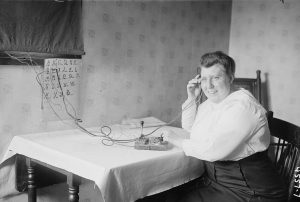 Weird Stuff
Weird Stuff  Weird Stuff
Weird Stuff  Our World
Our World 10 Archaeological Discoveries of 2025 That Refined History
 Weird Stuff
Weird Stuff 10 Fascinating Facts You Might Not Know About Snow
 Miscellaneous
Miscellaneous Top 10 Things Crypto Was Supposed to Change & What Actually Did
 History
History 10 Huge Historical Events That Happened on Christmas Eve
 Music
Music 10 Surprising Origin Stories of Your Favorite Holiday Songs
 History
History 10 Less Than Jolly Events That Occurred on December 25
 Weird Stuff
Weird Stuff 10 Funny Ways That Researchers Overthink Christmas
 Politics
Politics 10 Political Scandals That Sent Crowds Into the Streets
 Weird Stuff
Weird Stuff Ten Bizarre Facts About The Doge Meme
 Weird Stuff
Weird Stuff 10 Weird Things People Used to Do at New Year’s
 Our World
Our World 10 Archaeological Discoveries of 2025 That Refined History
 Weird Stuff
Weird Stuff 10 Fascinating Facts You Might Not Know About Snow
Who's Behind Listverse?

Jamie Frater
Head Editor
Jamie founded Listverse due to an insatiable desire to share fascinating, obscure, and bizarre facts. He has been a guest speaker on numerous national radio and television stations and is a five time published author.
More About Us Miscellaneous
Miscellaneous Top 10 Things Crypto Was Supposed to Change & What Actually Did
 History
History 10 Huge Historical Events That Happened on Christmas Eve
 Music
Music 10 Surprising Origin Stories of Your Favorite Holiday Songs
 History
History 10 Less Than Jolly Events That Occurred on December 25
 Weird Stuff
Weird Stuff 10 Funny Ways That Researchers Overthink Christmas
 Politics
Politics 10 Political Scandals That Sent Crowds Into the Streets
 Weird Stuff
Weird Stuff Ten Bizarre Facts About The Doge Meme
Ten Tremendous British Achievements
In our era of pillorying historical oppressors, Britain often gets a bad rap. And while England’s record on the world stage has been checkered, this is also a nation that granted former colonies like Australia, Canada, and India autonomy and, of course, singlehandedly stood up to Nazi Germany in 1940—a finest hour not only for Brits but for Western Civilization.
Back on the good ol’ isle, England also is home to some of the world’s most remarkable innovations and cultural achievements. Here are just ten of many.
Related: 10 Accidental Inventions That Changed The World
10 Power Plant: The Seed Drill
Prior to the 1700s, farmers planted almost exclusively by hand, via one of two manual approaches. The first wasted seed, the second wasted energy.
One method simply involved scattering seeds across the soil. The drawbacks were obvious: the seeds were too shallow to take root, prone to be eaten by birds, and often too close to each other for adequate nourishment. On the flip side, burying and spacing individual seeds was an incredibly slow, meticulous process that required excesses of time and manpower.
That was until an Englishman who didn’t deserve to have so crappy a rock band named after him changed farming forever. His name was Jethro Tull, and he sparked the Agricultural Revolution.
In 1701, Tull invented the seed drill, a cylinder-driven contraption featuring a hopper to store seed and a funnel to direct it. A plow at the front helped create neat rows, and a soil-covering device called a harrow pulled dirt back atop the planted seeds. Soon, the drill evolved from a one-man, one-row device to a multi-row machine pulled by horses.
The seed drill helped pave—or rather, plow—the way for a rapid succession of agricultural advancements in 18th-century England. In addition to bolstering interest in other new technologies, highlights included better drainage, scientific methods of crop breeding, and experimentation with systems of crop rotation that drastically reduced the need to keep fields intermittently fallow. Profits and food production soared.[1]
9 Conquering Distance, Part 1: The Telegraph

Most history buffs would be familiar with the person who developed Morse code because his name is… well, Morse. The system of dashes and dots was devised in the 1830s and ’40s by Samuel Morse, an American who also founded New York University. But Morse invented a language, not a medium. That medium, the telegraph, was among the most progress-prompting inventions of the 19th century—and was the brainchild of two Englishmen.
In the early 1800s, two milestones paved the way for the telegraph’s emergence. The first was the invention of the battery, in 1800, by Italian physicist Alessandro Volta. The second came two decades later when the Danish physicist Hans Christian Oersted successfully deflected a magnetic needle with an electric current—showcasing the connection between electricity and magnetism.
Basically, Oersted proved that you could “send” and “receive” controlled bits of data over a long-distance wire. While an American team that included Morse is often credited with inventing the telegraph, it was two English researchers—Sir William Cooke and Sir Charles Wheatstone—who actually devised the first commercially useful model.
Cooke and Wheatstone’s system comprised five magnetic needles that could be pointed around a panel of letters and numbers by using an electric current. Well before Morse sent his famous message from Washington, DC, to Baltimore (“What hath God wrought?”) in 1844, the British system was being used for railroad signaling in the UK, making train travel both faster and safer.[2]
8 Conquering Distance, Part 2: The Train
Speaking of trains, an Englishman invented those too.
The history of the steam-powered locomotive has its roots in (of course) the steam-powered engine, which was invented way back in 1698 by another Englishman, Thomas Savery. While never intended for hauling heavy cargo via rail—in fact, such a thing really hadn’t been dreamed of to that point—other engineers and inventors were able to stand on Savery’s shoulders to gradually increase both reliability and power.
For the steam-powered engine to reach train-worthy strength, though, would take a while. The first self-propelled steam engine wasn’t designed until 1760 by Scotsman James Watt and his assistant William Murdoch. Even then, though their model worked, they never built a full-scale, functioning locomotive.
That distinction took another forty-plus years when Englishman Richard Trevithick constructed a locomotive that completed the first-ever steam-powered rail journey. The date was February 21, 1804, and Trevithick’s train lugged fives carriages, ten tons of iron, and 70 passengers.
Unfortunately, so complicated a contraption inevitably had flaws, and Trevithick’s invention wasn’t widely adopted. Rail’s first commercial success story was George Stephenson, another Englishman whose Locomotion No. 1 design was used for the first public steam railway in the world. The line launched in September 1825, traveling between Stockton and Darlington.[3]
7 Birthplace of the Industrial Revolution
Give or take a few years, the modern world began in Britain around 1760. That’s when the Industrial Revolution began transforming England first and then much of the world from a hyper-local agrarian and merchant society to one dominated by mechanized manufacturing and long-distance supply chains. The dawn of factory production shaped not only the way goods were produced but also the ways in which people worked, where and how they lived, and how they saw themselves compared to fellow citizens.
The Industrial Revolution sparked a game-changing domino effect in which technology altered socioeconomics, which, in turn, altered the overall culture. In England, those technological advancements and the sweeping changes they brought were early, swift, and multi-faceted.
One aspect was the novel ability to efficiently construct buildings, infrastructure, and goods with iron and steel. This was driven by new energy sources like coal, the steam engine, electricity, and petroleum. Inventions like the spinning jenny and power loom made it easier to produce textiles and clothing, and transportation improvements like the locomotive made mass production economically viable since goods could be affordably shipped to non-local consumers.
All this new work, of course, needed workers within commuting distance. By 1831, London became the most populous city in the world and remained that way well into the 20th century. Some of this work was specialized; much of it wasn’t—a division of labor issue that segues into our next entry.[4]
6 Power to the People: Organized Labor
By sheer necessity, the Industrial Revolution gave rise to the modern concept of an organized, unionized workforce. And since the former started in England, the latter did as well. Far before workers were fighting for fairer treatment in latter-day labor hotspots like New York, Dublin, and Paris, manufacturing hubs like London and Manchester were experiencing the birth of the labor movement.
As rapid, factory-centric economic expansion drew rural workers, women, and even children to urban manufacturing centers, the pool of unskilled and semi-skilled labor soon became larger than the need for them. The direct result was long hours and poverty wages—and the direct results of THAT were the first attempts at collective bargaining.
It wouldn’t come easy. In 1799, the first of two Combination Acts banning trade unions was passed. Yet British workers persisted. By the 1810s, labor organizations to bring together workers of divergent occupations were formed. The first of these may have been the General Union of Trades, founded in Manchester in 1818.
Following the Combination Acts’ repeal in 1824, the stage was set for larger-scale unionization. In 1830, John Doherty established the National Association for the Protection of Labour, which enrolled about 150 unions from a variety of industries, including textiles, mechanics and blacksmiths, and various others.[5]
5 The British Are Building: Architecture
The English have been at the forefront of various architectural periods, stretching back to prehistory (Stonehenge much?). Tudor, Stuart Georgian, and Medieval styles, from Anglo-Saxon and Norman to Gothic and Vernacular: all were either influenced by or inherent to English culture.
The Victorian Era is among English architecture’s most interesting periods. Starting in the 1830s and continuing through the early 20th century, Victoria’s reign saw the rise or resurgence of several well-known styles, including Gothic revival, Italianate, Second Empire, Queen Anne, stick style, Romanesque style, and shingle style.
Notably, the period saw renewed interest in English vernacular building traditions, employing features such as tile-hanging and the particularly telltale half-timbering—a style in which external and internal walls are constructed of timber frames, then filled in with brick or plaster.
But while Victorian characteristics had commonalities with Gothic revival, the driving influences weren’t religious homages so much as romantic socialism and, especially, a distaste for industrialization and the urbanity it birthed. To some extent, then, the Victorian Era was an unsurprisingly timed architectural backlash to the Industrial Revolution—yet another example of its seemingly ubiquitous influence in England.
Ironically (pun intended!), Industrial Age technology soon became a factor as well. In the latter half of the 19th century, iron and steel frame construction increased, though its use was often masked by traditional forms. These traits were exhibited in two rapidly proliferating new building forms: dozens of railway stations and remarkable glasshouses like the one in London’s Kew Gardens.[6]
4 Advantage England: Tennis, Anyone?
Few sports are truly global, and those that are—most notably football—often have murky origin stories. Baseball, hockey, and American football are too regional, while golf is too athletic-agnostic to be considered… well, a sport.
The only two major sports with worldwide appeal and a definable origin are basketball and tennis. The former was invented by a Canadian, the latter by an Englishman.
While civilizations dating back to Neolithic times have devised games utilizing forms of balls and rackets, nothing resembling today’s structured game gained prominence. Even the indoor courts that flourished in England starting in the late 1400s had little in common with Centre Court at Wimbledon.
It took two things for modern tennis to arrive. The first was the advent of vulcanized rubber in 1850, which yielded balls suitable for outdoor play on grass. The second was definable rules. So in 1873, Londoner Major Walter Wingfield drew up the guidelines for tenni…
… um, Sphairistikè.
Greek for “playing ball,” Wingfield’s brainchild played out on an hourglass-shaped court. Soon rebranded as tennis, the game created a sensation in Europe, the USA, and even China and is the genesis of the modern sport. It was also reshaped to the rectangular court recognizable today—an alteration that made its grand debut in 1877 at the All England Croquet Club. It was the first of what ranks among the world’s premier annual sporting events: Wimbledon. Berries and cream for all.[7]
3 The Toothbrush (Yes, Really)
Unsurprisingly, the desire to keep our teeth from rotting out of our skulls has existed for about as long as teeth have. As early as 5000 BC, ancient Egyptians scrubbed their pearly not-so-whites with a powder derived from ox hooves and eggshells, which four out of five oxen certainly do not recommend. The Romans opted for sticks with frayed ends—a good idea if you don’t like having gums. The Greeks used rough cloth, which really just screams “out of ideas.”
About 800 years ago, the Chinese began assembling makeshift toothbrushes by attaching coarse animal hairs to bamboo or ivory. But the first thing remotely resembling a modern-day toothbrush wasn’t invented until the late 1700s by an Englishman named William Addis.
Apparently, Addis had been fighting more than cavities and gingivitis because he’d gotten himself arrested for inciting a riot. In fact, he both thought up and constructed his signature idea while rotting, presumably along with his teeth, in prison.
To preserve both his sanity and his chompers, Addis drilled holes in a carved bone handle and inserted boar bristles, both of which were apparently readily available in 18th-century English prisons. He then used wire to hold the bristles in place. Addis started mass-producing his contraption after his release and died a wealthy man.
The rest is history: his countrymen marveled at the invention, adopted it into their daily routines, and enjoyed perfect teeth from that point forward…[8]
2 Classical Music
Everyone is aware of the UK’s influence on modern music. From the Beatles and the Rolling Stones to the Clash, the Smiths, and Adele, worldwide radio playlists would be far thinner without the Brits.
Less celebrated (at least nowadays) is England’s influence on classical music. Interestingly, many of the best English composers date not from the time of Bach (1685–1750) or even Beethoven (1770–1827) but slightly later: the mid-1800s into the early 1900s. Including Ireland, which was annexed into the UK in 1801, British music of this period traces its roots back as early as the 1200s. And while it certainly didn’t exist in a vacuum from the influences of mainland Europe, the UK’s island geography helped it develop distinctly English themes and frameworks.
Perhaps the most noteworthy is Edward Elgar (1857–1934). Atypically for English composers, many Elgar works, including the Enigma Variations, the Pomp and Circumstance Marches, and the Cello Concerto, have become mainstays of the international classical catalog. A Catholic in a Protestant land, Elgar thought of himself as an outsider—a stiff-upper-lip melancholy reflected in his music.
Despite dying in his mid-30s, possibly from poisoned chocolate, one of England’s earliest greats is Henry Purcell (1659–1695). Though influenced by Italian and French styles, Purcell’s trademark is a uniquely English version of Baroque. Along with John Dunstaple and William Byrd, Purcell is regarded among the greatest composers prior to England’s “classical renaissance” of the 18th and 19th centuries.[9]
1 The Reflecting Telescope
One hundred and twenty-five years after Pole Nicolaus Copernicus voiced his radical theory that the Earth revolved around the sun—and not vice versa—an Englishman invited everyone to take a better look for themselves.
In the mid-1600s, Woolsthorpe, Lincolnshire-born Isaac Newton was studying the properties of light. A key detriment to early astronomers were bands of color, which obscured and therefore limited the detail with which they could observe the skies. Realizing these colors were formed from light passing through a lens or prism, Newton concluded that white light is actually a mixture of differently-colored light.
The actionable takeaway was that telescopes with lenses simply weren’t going to cut it because chromatic aberrations would continue to hamper astronomers’ work. And now that he understood the problem, Newton set to work developing a solution that ranks among science’s most important breakthroughs.
Newton’s invention amounted to a seemingly counterintuitive approach to telescopic science. Rather than a lens to focus the light from a star, Newton instead used a mirror. After experimenting with various metals and polishing methods, the first reflecting telescope debuted in 1668 when Newton showcased the contraption to the science-centric Royal Society of London. The demonstration was so successful that they granted Newton membership on the spot, and the exponentially improved clarity would serve as the genesis of future astronomic discoveries.[10]








